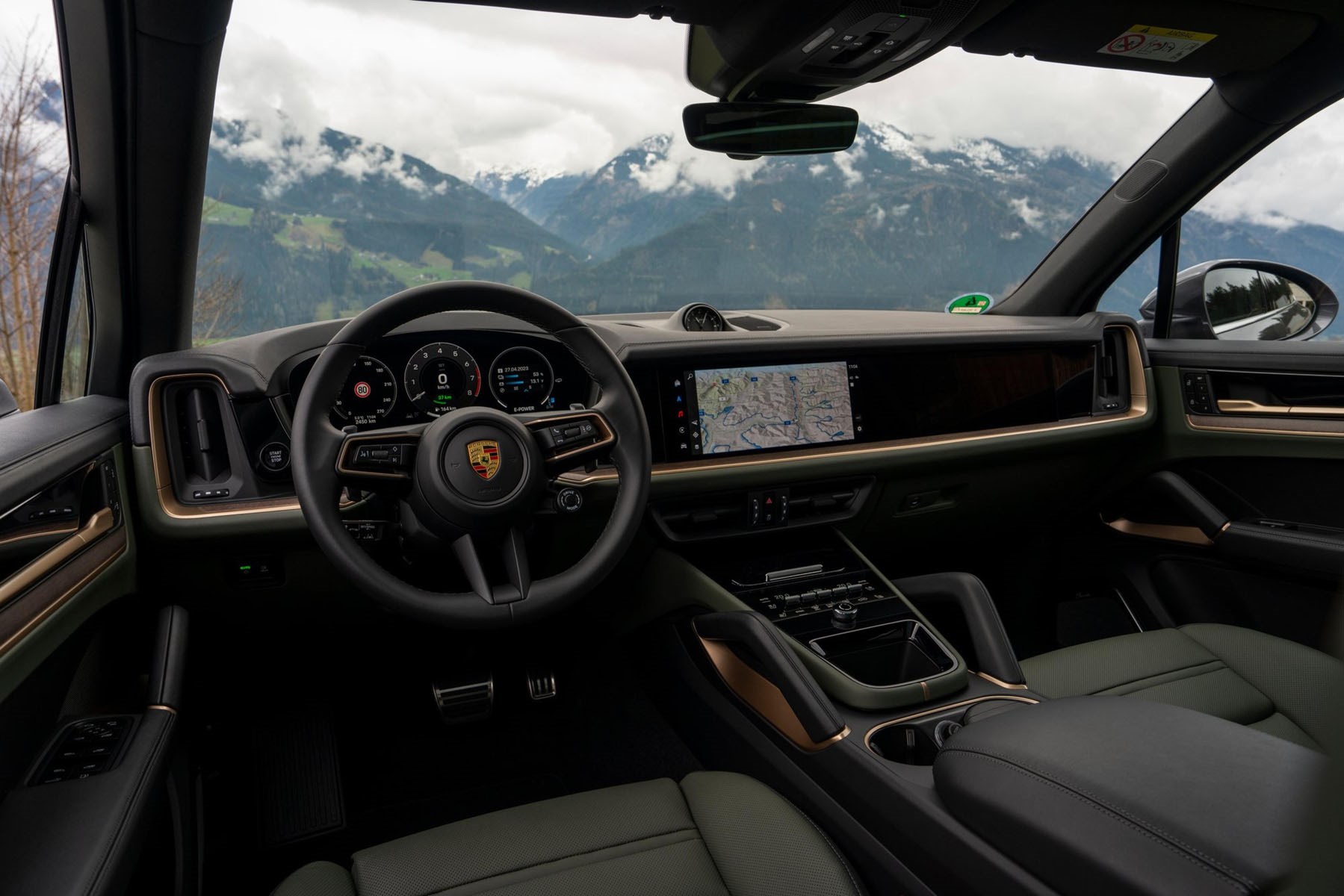► Range priced from £67,400, E-Hybrid £76,800
► New looks, cabin, engine and suspension
► E-Hybrid gets a 46-mile WLTP range
Welcome to the new Porsche Cayenne SUV. OK, it’s not totally new – it’s technically a facelift of the third-gen car first unveiled in 2017 – but given the vast array of changes across the board it’s hard to argue that this is any less than a significant revamp.
On the menu are tweaks to the exterior design, a heavily revised interior with additional tech, an overhauled engine line-up and changes to the passive and adaptive suspension offerings. Some facelift, right?
Read on for our full Porsche Cayenne E-Hybrid review to see if it’s good enough to join the ranks of the best hybrid cars on sale today.

Casual observers might be led to believe that the original model was losing its competitive edge and while some elements were beginning to look a little dated, the Cayenne remained one of the best performance SUVs on the market – an arena that covers the Range Rover Sport, BMW X5 and even the Lamborghini Urus. Tough competition, so have the updates made a difference?
New looks, inside and out
First off, the looks. On the outside there’s a new front and rear end design complete with reimagined taillamps, as well as more strongly arched wings. The headlamps have also been tweaked, with Matrix LEDs now standard. Optional HD Matrix LEDs feature more than 32,000 pixels per headlamp, with 1000 steps of brightness depending on the driving situation. Clever.
The range of colours on offer has also been expanded, while wheel designs have also been refreshed and go through 20-, 21- and 22-inch sizes. In short, you’re not going to mistake the latest model for a pre-facelift variant, especially if you have a peek inside.
As is now the norm, the cabin is dominated by digital displays yet, as is the Porsche way, it doesn’t feel OTT and – rejoice – you’ve still got physical controls for the air-con and heated seats.
That’s due to the repositioning of key controls, including the gearlever being shrunken down to 911 size and moved up to the right of the steering wheel just like on the Taycan EV. Controversial, but not as much as the nice, tactile Porsche starter ‘key’ being replaced by a button now positioned on the left of the steering column. Boooo.

Look past this and the 12.6-inch digital instrument cluster and optional head-up display sits dead ahead of the driver, with the former offering several different configurations. Thankfully, these include a digital equivalent of the five Porsche dials with rev counter in the middle that, although not as classy as the physical equivalents, are still super clear and easy on the eye.
Glance across and 12.3-inch Porsche Communication Management (PCM) display is as crisp and up-to-date as the latest iPhone, yet it’s the screen next to it that stands out.
Available as an option, the 10.9-inch passenger information display shows performance data and infotainment functions (including watching a movie) yet avoids distracting the driver thanks to a reflective film that blocks out the view. Just like the age-old Jaguar twin-screen tech.

Another interior detail that deserves a mention is the cooled wireless phone charger. Ever had to stop using one because your phone has overheated? The cooling element allows optimised charging of up to 15 watts and will make sure your mobile won’t frazzle with contactless charging. Sounds like a gimmick, yet it actually works well in reality.
New range of engines
Initially, the Cayenne will be available with three engines. The base 3.0-litre V6 turbo, the Cayenne E-Hybrid (3.0-litre V6 turbo with electric motor) and the 4.0-litre V8 bi-turbo. We spent most of our time driving the hybrid and for the most part it’s a pleasing experience.
With 468bhp and 443lb ft of torque on tap, performance is brisk for a 2.4-tonne SUV and the integration of the 130kW electric motor and petrol engine is smooth. Battery size has grown from the pre-facelift car, going from 17.9 kWh to 25.9 kWh, meaning a WLTP electric range of up to 46 miles. An 11 kW onboard charger means 0-100% charge in just under 2.5 hours.

For those looking for silent EV comfort and running costs teamed with the convenience and excitement of a petrol engine, the E-Hybrid is a strong proposition among rivals, yet it’s not perfect.
Apply the brakes and the hybrid regen means the pedal feel isn’t the usual deft Porsche fare, while the sheer mass of the E-Hybrid vs the regular Cayenne (you’re looking at nearly a 400kg difference!) means it doesn’t move with quite the same verve. It’s still positive as far as large hybrid SUVs go, but it’s not the Cayenne at its dynamic best.
Tweaked suspension all-round
Opt for the standard steel springs and you’ll be treated to new two-valve shock absorbers with a modfied set-up delivering greater comfort at low speeds and better pitch and roll support during faster driving. Sounds promising as the Cayenne was never at its best when not fitted with optional air suspension, yet sadly none of the cars on our launch rotation came fitted with the passive set-up.
However, we can confirm that the models fitted with adaptive air suspension (now with sharper differentiation between Normal, Sport and Sport Plus driving modes) still ride and handle brilliantly for a car of this weight and size. Body roll is kept to spookily low levels, while turn in and all-round balance are sweet and expertly judged. Granted, previous Cayennes were perhaps more focused on outright performance, but the overall dynamic performance is still deeply impressive.

Thankfully, this doesn’t come at the expense of comfort and refinement, for the Cayenne can so easily leave aside its sporting abilities for a secure, relaxed gait that every luxury SUV really ought to specialise in. Even with the larger wheels, the isolation of bumps and ruts into the cabin is exceptional and delivers arguably the most luxurious experience you’ll find in a car from Stuttgart.
Porsche Cayenne review: verdict
Just as rivals may have been sensing blood at the apparent ageing of the Mk3 Cayenne, Porsche goes and delivers a significant makeover that sends its halo SUV back to the top of the pile. As is often the way, Stuttgart has ruthlessly identified areas for improvement and – by facelift standards – thrown the kitchen sink at them.
The end result is a car that’s better to drive, better to sit in and arguably better to look at than ever before. The E-Hybrid version may not be its finest incarnation, yet even in this form it still delivers one of the best large SUV experiences around. Like most Porsches, the Cayenne sets an imposing benchmark.







